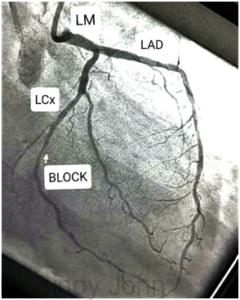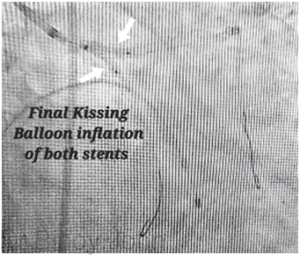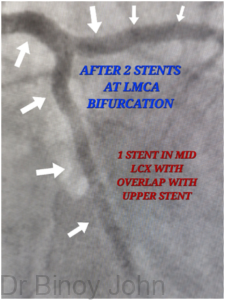What is Left Main Coronary Artery Angioplasty?
The heart has 3 arteries, the Right coronary artery (RCA) which supplies blood to the right side of the heart and a Left main (LM) artery which commonly divides into two giving rise to a Left anterior descending (LAD) artery and Left circumflex (LCx) artery. (See image) Less commonly the LM can trifurcate and give rise to a third branch called Ramus intermedius (RI). Angioplasty and stenting of blocks in left main coronary is called left main angioplasty. It is a complex procedure and different from angioplasty of other blocks and locations.

Why is the Left Main artery very important?
The left main artery is very important because it supplies 70% of the blood supply to the heart and therefore any block of the left main artery can cause a fatal heart attack and or cardiac arrest.
What is a Left Main bifurcation block?
Left main artery has three parts, the ostium or mouth, the end of the artery which divides into LAD artery, LCx artery and Ramus intermedius and the portion in the middle between the ostium and end, which is called the body or the shaft of the LM.
The classic LM Bifurcation block is when there are three blocks involving the end of the LM artery and the beginning or the mouth of both the LAD and LCx artery. This block is medically defined as Medina classification 1,1,1 (See image).

This is a very complex type of block which needs a complex and different type of angioplasty called Bifurcation angioplasty using 2 stents and special techniques. It is a high-risk subset of angioplasty where the stents are paced at the junction and carries a high risk of cardiac arrest during the procedure and therefore has to be performed by highly experienced and skilled interventional cardiologists. When the mouth of the third branch the Ramus intermedius, which is usually a smaller artery is also involved it is called a LM trifurcation block.
Generally LM blocks are referred for by-pass graft surgery. Angioplasty is a good option when the by-pass surgery risk is high and also very good for ostial and shaft LM blocks
How is the Left Main Bifurcation angioplasty done?
Procedure:
The procedure is ideally performed with coronary imaging (Read sections on Optical coherence tomography and Intra-vascular Ultra-Sound). There are several techniques for LM angioplasty, however the common techniques used in classic LM bifurcation angioplasty are the Double Kiss Crush Technique and The Cullotte Technique. The DK Crush technique described below is my personal favourite technique.
Watch video:
The procedure involves placing wires into both LAD and LCx arteries. Imaging is performed with IVUS or OCT to identify the nature of the block and sizes of the arteries. Thereafter, balloon dilatation of all the 3 blocks is performed. Thereafter one stent is placed in the LCx mouth region with slight protrusion into the LM. This stent is deployed and then the portion of stent in the LM is crushed with a balloon. Then a second stent is positioned from LM to LAD artery and deployed. A wire is then re-crossed into the LCx stent through the LM-LAD stent and finally a simultaneous inflation of two balloons are performed called Final Kissing balloon inflation, (See image)

to obtain complete opening of all the three blocks. (See image) A final imaging is done with OCT or IVUS to ensure perfect results.

Left Main Ostial and Shaft angioplasty:
When the block involves the ostium or mouth or the shaft of the LM, angioplasty can be performed for the same. Angioplasty to these areas are less complicated but can again be challenging as it requires the precise placement of the stent to cover the LM mouth and not to miss it. Cardiac arrest during the procedure is also a risk as there will be complete obstruction of blood flow during balloon dilatation and stent deployment. Intra coronary imaging with IVUS (See section on IVUS) is recommended during the procedure.
Procedure: Wires are placed in LAD and if needed LCx. Balloon dilatation of the block is performed. Imaging is done to take measurements of the LM and then a stent is positioned and deployed to obtain a good result.
Expertise: Dr Binoy John is highly experienced in the performance of LM angioplasty and stenting and has done numerous presentations and expert talks on these topics at various international and national interventional conferences. He has authored a chapter on left main angioplasty in a cardiology book. Left main coronary angioplasty is one of the most complex angioplasties and one which has to be done by the most experienced interventional cardiologists.
Talk @ 6 th CHIP CTO 2025, New Delhi
Talk @ 76 th Cardiological Society of India National Conference 2024, Lucknow






